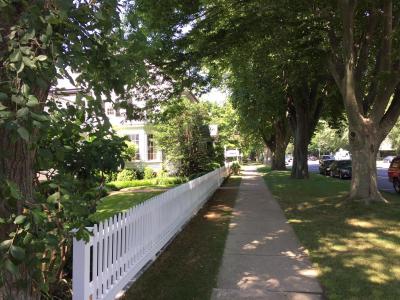Five Elms Doomed, Others at Risk

The elm trees lining Main Street and scattered around East Hampton Village, perhaps a foundation of the village’s designation as one of the most beautiful little burgs in America, are aging and becoming more susceptible to disease.
Several that have succumbed to Dutch elm disease have been taken down, and five more are presently due for the saw, despite the best efforts of the East Hampton Ladies Village Improvement Society, the 120-year-old institution that watches over and cares for the trees. Samples from close to a dozen more trees have been sent out for testing to see if they too have the disease, which killed a number of the village’s elms during nationwide epidemics in the ’70s and ’80s.
“We should know very soon,” said Olivia Brooks, who has headed the L.V.I.S. tree committee for a decade. “Dutch elm disease, we think, has come around again.”
One variety of American elm, called a Princeton elm, has been resistant to Dutch elm disease, she said. “Resistant, but not tolerant.” A Princeton elm growing at the sheepfold on Egypt Lane, near the Pantigo Road intersection, was only four or five years old, Ms. Brooks said, when it recently “all of a sudden turned yellow.” It had to be taken down.
As with people, the trees weaken somewhat as they age, and their ability to ward off disease wanes. The so-called Baker elm, which grew near the Gardiner “Brown” House, on Main Street at the entrance to the parking lot, was likely more than 200 years old at the time of its demise in the 1990s. A table made from its wood by Phil Berg, a local woodworker, can be seen in the society’s bookstore, next to its thrift shop in the Gardiner “Brown” House.
Other centuries-old trees, elms that have survived past disease outbreaks, are showing signs of distress and are being carefully monitored, Ms. Brooks said, to determine if their symptoms stem from advanced age, the effects of recent prolonged drought, or something more ominous.
But Dutch elm disease, which is believed to have been brought over, shipboard, from England, and has swept at times throughout the Northeast, can strike trees of any age.
L.V.I.S. tree committee members are deployed in “street teams” to go into the field and inspect. According to Mary Fallon, the head tree protector on the elm task force, the new victims that will be removed soon are two trees on Meadow Way, called witch elms, and others on Main Street and Buell Lane.
“It’s sad, because we’ve had some really good years,” she said. “It appears that the dryness from the last summers has taken its toll.”
The L.V.I.S. program of planting and maintaining trees dates back, Ms. Brooks said, to probably the 1920s. The tree committee, and its elm task force, works with the Village of East Hampton; they share the costs of tree care, including a fungicide treatment administered by Bartlett Tree Experts.
Dutch elm disease can be transmitted by beetles that bore into tree bark and deposit the disease that they carry on their bodies, or underground through root systems, Deborah Green, a board-certified master arborist at Bartlett, explained recently. The roots “are, like, holding hands under there,” allowing disease to spread from tree to tree.
The fungicide treatment, administered to a third of the village’s elm trees each year on a cyclical protocol, can act as a preventative, or even a curative.
“If it’s an isolated tree that’s caught early on, you might be able to suppress the disease for awhile,” Ms. Green said. But success depends on the overall health of the tree. Those that are “really old — they’ve been on a downhill curve for many years. Then you throw drought in there, and other human factors. . . .”
Driving over the tree roots can have a negative impact, and the L.V.I.S. worked with the village to enact a law requiring fencing around village trees near construction sites to protect them from trucks and other machinery. The society recently committed $153,300 to ongoing maintenance and planting of trees, and at a meeting earlier this month made the sad but necessary decision to budget $19,600 to remove the five known diseased elms.
Ms. Brooks, a lifelong East Hampton resident, waxed poetic about the elm trees. Some of the largest in the village are 150 to 200 feet tall. “They have those beautiful arms,” she said, that create an overhanging bower. “They just have a beautiful structure.”
Old postcards of East Hampton show a village of open spaces with few trees. “L.V.I.S. was really instrumental” in changing the streetscape, Ms. Brooks said. “The ladies really wanted the trees to be one of the greatest resources out here, besides the ocean.” The elms are particularly visible and stately, but maples were also planted, and a variety of specimen trees.
Ms. Brooks has particularly enjoyed planting Princeton elms. “We have them dotted all over the village; I like the form of it,” she said.
The L.V.I.S. maintains a database that identifies all the village trees, and has photographs as well of their memorial and dedication plaques, almost 100 of them to date.
